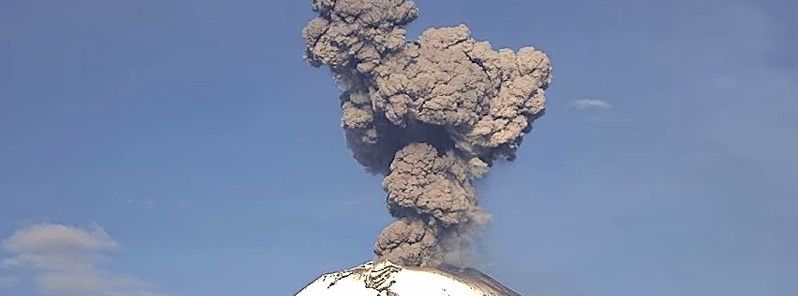Eruptions at Mexico’s Popocatépetl volcano cover nearby towns in ash

Monitoring systems at Mexico's Popocatépetl volcano registered three explosions and 136 low-intensity exhalations of steam, volcanic gases and light amount of ash on Saturday and Sunday, July 1 and 2, 2017.
Three explosions were registered with a moderate amount of ash to the northeast. The eruptions sent a column of smoke and ash up to 6.7 km (22 000 feet) above sea level.
Ashfall was reported in several towns in Mexico State, including Ozumba, Amecameca, Tlalmanalco, Chalco, Ayapango, Tenango del Aire and San Pedro Nexapa.
CENAPRED reminded that people SHOULD NOT go near the volcano, especially near the crater, due to the hazard caused by ballistic fragments.

Luis Felipe Puente, the national coordinator of Civil Protection, reminded residents to sweep roofs, attics, patios, and streets of all ash and place the ash in bags so it does not get into the water system. He also urged residents affected by the ashfall to cover their noses and mouths with masks or damp handkerchiefs, close any outdoor water supplies to avoid contamination, close windows, and remain at home during ashfall.
#Blog: Conoce algunas recomendaciones ante la caída de ceniza volcánica #Comparte https://t.co/qpdU1OP1Kv pic.twitter.com/EGRK07Cn09
— Luis Felipe Puente (@LUISFELIPE_P) July 2, 2017
The volcano is being placed in a Yellow Phase 2, which means it could continue to erupt at low to intermediate intensity. Authorities are asking that residents to remain away from the volcano and have set up a perimeter of 12 km (7.5 miles).
Geological summary
Volcán Popocatépetl, whose name is the Aztec word for smoking mountain, towers to 5 426 m (17 801 feet) 70 km (43.5 miles) SE of Mexico City to form North America's 2nd-highest volcano. The glacier-clad stratovolcano contains a steep-walled, 400 x 600 m (1 312 x 1 968 feet) wide crater. The generally symmetrical volcano is modified by the sharp-peaked Ventorrillo on the NW, a remnant of an earlier volcano. At least three previous major cones were destroyed by gravitational failure during the Pleistocene, producing massive debris-avalanche deposits covering broad areas to the south. The modern volcano was constructed south of the late-Pleistocene to Holocene El Fraile cone.
Three major plinian eruptions, the most recent of which took place about 800 CE, have occurred from Popocatépetl since the mid Holocene, accompanied by pyroclastic flows and voluminous lahars that swept basins below the volcano. Frequent historical eruptions, first recorded in Aztec codices, have occurred since precolumbian time. (GVP)
Featured image: Popocatepetl erupting on July 2, 2017. Credit: WebCamsDeMexico

Commenting rules and guidelines
We value the thoughts and opinions of our readers and welcome healthy discussions on our website. In order to maintain a respectful and positive community, we ask that all commenters follow these rules.